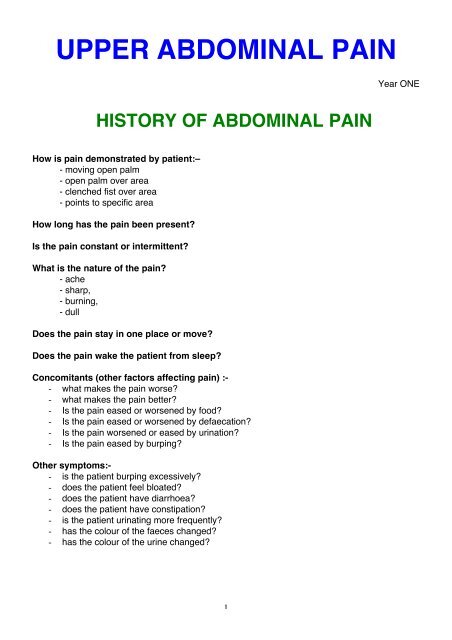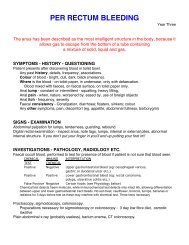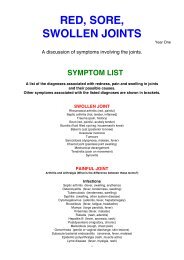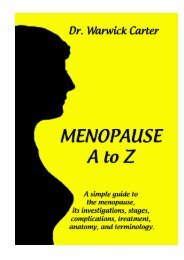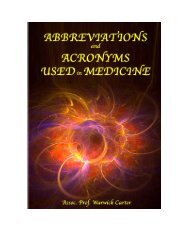UPPER ABDOMINAL PAIN - Medwords.com.au
UPPER ABDOMINAL PAIN - Medwords.com.au
UPPER ABDOMINAL PAIN - Medwords.com.au
Create successful ePaper yourself
Turn your PDF publications into a flip-book with our unique Google optimized e-Paper software.
<strong>UPPER</strong> <strong>ABDOMINAL</strong> <strong>PAIN</strong><br />
Year ONE<br />
HISTORY OF <strong>ABDOMINAL</strong> <strong>PAIN</strong><br />
How is pain demonstrated by patient:–<br />
- moving open palm<br />
- open palm over area<br />
- clenched fist over area<br />
- points to specific area<br />
How long has the pain been present<br />
Is the pain constant or intermittent<br />
What is the nature of the pain<br />
- ache<br />
- sharp,<br />
- burning,<br />
- dull<br />
Does the pain stay in one place or move<br />
Does the pain wake the patient from sleep<br />
Con<strong>com</strong>itants (other factors affecting pain) :-<br />
- what makes the pain worse<br />
- what makes the pain better<br />
- Is the pain eased or worsened by food<br />
- Is the pain eased or worsened by defaecation<br />
- Is the pain worsened or eased by urination<br />
- Is the pain eased by burping<br />
Other symptoms:-<br />
- is the patient burping excessively<br />
- does the patient feel bloated<br />
- does the patient have diarrhoea<br />
- does the patient have constipation<br />
- is the patient urinating more frequently<br />
- has the colour of the faeces changed<br />
- has the colour of the urine changed<br />
1
<strong>UPPER</strong> <strong>ABDOMINAL</strong> <strong>PAIN</strong><br />
COMMON CAUSES OF <strong>ABDOMINAL</strong> <strong>PAIN</strong><br />
A wide range of conditions,<br />
including conditions centered outside the abdomen,<br />
may c<strong>au</strong>se upper abdominal pain.<br />
COMMON CAUSES OF <strong>PAIN</strong> IN VARIOUS REGIONS OF THE ABDOMEN<br />
A Right Upper Quadrant : Acute cholecystitis, biliary colic, hepatitis, pneumonia<br />
B Epigastrium : Peptic ulcer, gastritis, pancreatitis, Crohn’s disease, heart disease<br />
C Left Upper Quadrant : Splenomegaly ( c<strong>au</strong>se), irritable bowel syndrome, basal<br />
pneumonia.<br />
D Right Loin : Ureteric colic, pyelonephritis, duodenal ulcer.<br />
E Periumbilical : Early appendicitis, small bowel obstruction, perforated peptic ulcer,<br />
ruptured aortic aneurysm, mesenteric artery occlusion, Crohn’s disease, Meckel’s<br />
diverticulitis.<br />
F Left Loin : Ureteric colic, diverticulitis, irritable bowel syndrome, pyelonephritis.<br />
G Right Iliac Fossa : Appendicitis, mesenteric adenitis, ureteric colic, unruptured ectopic<br />
pregnancy, ovarian cysts, Meckel’s diverticulitis, salpingitis, inguinal and femoral hernia,<br />
testicular torsion<br />
H Hypogastrium : Large bowel obstruction, ruptured ectopic pregnancy, cystitis, uterine<br />
cramps, endometriosis, pelvic inflammatory disease.<br />
I Left Iliac Fossa : Gastroenteritis, colonic carcinoma, ureteric colic, diverticulitis,<br />
unruptured ectopic pregnancy, ovarian cysts, ulcerative colitis, constipation, salpingitis,<br />
inguinal or femoral hernia, testicular torsion<br />
2
<strong>UPPER</strong> <strong>ABDOMINAL</strong> <strong>PAIN</strong><br />
<strong>UPPER</strong> <strong>ABDOMINAL</strong> ORGANS<br />
LIVER<br />
The liver is the largest gland and internal organ in the body. Wedge-shaped, smooth and<br />
rubbery, it lies behind the lower few ribs on the right side, weighs about 1.5 kg and has the<br />
same reddish brown colour as the animal livers we are familiar with in the butcher shop. The<br />
liver plays an integral part in the processing of food (metabolism).<br />
The liver is body's chemical processing plant. It regulates the amount of blood sugar,<br />
assists in producing the blood clotting mechanisms, helps to nourish new blood cells,<br />
destroys old blood cells, breaks down excess acids to be eliminated as urine, stores and<br />
modifies fats so they can be more efficiently utilised by cells all over the body, stores certain<br />
vitamins and minerals, and removes poisons from harmful substances such as alcohol and<br />
drugs. The liver is also an important source of the heat, which is essential to maintain the<br />
body's temperature.<br />
The liver aids the digestive process by manufacturing bile, which mixes with the digestive<br />
juices in the duodenum. Bile is a thick yellowy green liquid containing salts that breaks<br />
down fat into small droplets so that it can more easily be digested. It is manufactured<br />
constantly, but bec<strong>au</strong>se it may be required only a few times a day, it is carried from the liver<br />
through ducts to the gall bladder, a small pear-shaped bag lying just under the liver, where it is<br />
stored until it is needed.<br />
Once bile salts are manufactured, the body makes the most of them. Having fulfilled their<br />
digestive purpose in the small intestine, they are not simply discarded but are recycled through<br />
the blood and back to the liver to be used again. It is estimated that this recycling process takes<br />
place about 18 times with only about 5% of salts being eliminated in the faeces each time.<br />
One of the functions of the liver is to remove a yellow pigment called bilirubin, produced by<br />
the destruction of old red blood cells, from the blood. If the liver be<strong>com</strong>es diseased and cannot<br />
function properly, this yellow pigment stays in the bloodstream and gives a yellowish tinge to the<br />
skin and whites of the eyes - the j<strong>au</strong>ndice that is a striking symptom of liver diseases such as<br />
hepatitis.<br />
The chemical processing capabilities of the liver are amazingly <strong>com</strong>plex and wide-ranging.<br />
Substances that enter as one thing frequently leave as something else, depending on the<br />
body's needs. For example, most amino acids are converted into proteins, but if the body is<br />
3
<strong>UPPER</strong> <strong>ABDOMINAL</strong> <strong>PAIN</strong><br />
short of glucose, the liver will <strong>com</strong>bine some of the amino acids with fat to make extra sugar.<br />
Similarly if the level of blood sugar is too high, glucose is converted into a substance that can be<br />
stored.<br />
The liver's storage capacity is equally attuned to the body's specific needs at any given time.<br />
If more vitamins are consumed than the body immediately needs, certain of them will be stored<br />
to be released if the supply falls off. A person could survive as long as 12 months without taking<br />
in any vitamin A, and for up to four months without new supplies of vitamins B12 and D.<br />
PANCREAS<br />
The pancreas is a large gland situated almost exactly behind the navel in the belly. It is about<br />
15 cm. long and lies horizontally across the abdomen and is surrounded by the duodenum and<br />
stomach.<br />
The pancreas has two quite distinct roles to play in the functioning of our body.<br />
Insulin, the chemical vital for the control of the body's use of sugar and the prevention of<br />
diabetes, is produced by special cells (islets of Langerhans) scattered throughout the tissue of<br />
the pancreas. The insulin is produced and released according to how much we eat, not only of<br />
sugar but also carbohydrate. The cells that produce the insulin have no ducts to take the<br />
chemical away, but discharge it directly into the blood vessels surrounding each cell. Once in<br />
the bloodstream, insulin controls the level of sugar inside the cells and in the blood. In diabetics,<br />
insulin is either not produced, or is made ineffective by other problems in the body.<br />
Another hormone, glucagon, is also produced in the pancreas as a counter to insulin in<br />
controlling blood sugar levels.<br />
The other function of the pancreas is to produce the main digestive enzymes (pancrelipase,<br />
chymotrypsin and other digestive enzymes) used in the digestion of food in our stomach.<br />
Millions of tiny glands produce powerful enzymes, which are taken through a maze of ducts<br />
finally joining into one main duct that in turn joins with the bile duct to empty into the duodenum.<br />
As food passes through the duodenum, the digestive juices produced in the pancreas are<br />
squirted onto it. The churning action produced by contractions of the intestine mix these juices<br />
4
<strong>UPPER</strong> <strong>ABDOMINAL</strong> <strong>PAIN</strong><br />
into the food, where they break it down into its basic <strong>com</strong>ponents so that it can be absorbed into<br />
the body.<br />
The duct <strong>com</strong>ing from the pancreas joins with the bile duct then this <strong>com</strong>mon duct open into<br />
the duodenum through a small hole in the side of the intestine called the ampulla of Vater. Thus<br />
stones <strong>com</strong>ing down from the gall bladder can block off the pancreatic juices too. This can lead<br />
to a build-up of pressure in the pancreas, forcing the powerful pancreatic enzymes to leak into<br />
the abdominal cavity. When this happens the juices digest normal tissues instead of the food<br />
they are intended for. This c<strong>au</strong>ses the severe pain of acute pancreatitis, and serious illness and<br />
even death can result.<br />
Sphincter of Oddi<br />
The sphincter of Oddi is a small muscle ring that surrounds the opening of the <strong>com</strong>mon bile<br />
and pancreatic duct (the ampulla of Vater) into the side of the duodenum. It may trap a gallstone<br />
at this point c<strong>au</strong>sing a back up of bile and pancreatic enzymes, and eventually pancreatitis. The<br />
sphincter may be cut during an ERCP (endoscopic retrograde cholecystopancreatography)<br />
procedure to allow a trapped gallstone to escape.<br />
SPLEEN<br />
The spleen is the largest and most sophisticated lymph node in the human body. It is a soft<br />
dark red organ that weighs about 100g and is roughly the same size as a clenched fist. Shaped<br />
rather like an inverted pudding bowl, it is in the abdominal cavity tucked under the lower ribs on<br />
the left side.<br />
The spleen has three main functions:-<br />
- it filters blood, removing damaged cells and extracting and storing reusable<br />
elements such as iron from these cells.<br />
- it stores antibodies developed by the body during an infection, so that when a<br />
similar infection occurs in the future the antibodies can be called into play quickly.<br />
- it helps to produce from stem cells, along with bone marrow, new red and white<br />
blood cells. White cells fight infection and red cells transport oxygen.<br />
The most frequent reason for medical attention is that the spleen is damaged in an accident.<br />
If the chest is squashed, in a car accident, the spleen may be pierced by a rib or ruptured by the<br />
pressure. Bec<strong>au</strong>se it consists of a very large number of blood vessels, it bleeds freely, and the<br />
blood loss into the abdomen may be life threatening. It is difficult to repair surgically bec<strong>au</strong>se it<br />
is a bit like trying to sew up sponge rubber - the stitches tear out very easily and every stitch<br />
5
<strong>UPPER</strong> <strong>ABDOMINAL</strong> <strong>PAIN</strong><br />
hole bleeds. It is therefore sometimes necessary to remove it to save the victim's life. The<br />
removal of the spleen has remarkably little effect on an adult, bec<strong>au</strong>se the bone marrow can<br />
take over most of its functions. In babies, the situation is rather different, as the spleen is<br />
essential for the early formation of blood cells, and it is removed from children only if there is no<br />
alternative.<br />
If the spleen be<strong>com</strong>es overactive, it may destroy blood cells too rapidly so that the person<br />
be<strong>com</strong>es severely anaemic, susceptible to infection, and bleeds and bruises excessively.<br />
STOMACH<br />
The process of digestion, which begins in the mouth, continues in the stomach. Chewed food<br />
is passed from the mouth down the oesophagus (gullet) to the stomach. The stomach is a J<br />
shaped bag that expands with the intake of food, and after a large meal may be 30cm. long and<br />
12 cm. in diameter. It can hold up to 3 litres in a large person when full. It is soft and pliable<br />
when empty but be<strong>com</strong>es firm when filled with food. It is on the left side of the body, behind the<br />
lower ribs, high in the abdomen not far below the heart, and not down behind the navel as<br />
people often believe.<br />
The stomach digests food and also stores food, which has usually been taken in quite quickly<br />
as a meal, and releases it slowly to be processed by the small intestine.<br />
The outside layers of the stomach consist of muscle, while the inside lining is a mucous<br />
membrane, much the same as that lining the oesophagus. The membrane in the stomach,<br />
however, forms many folds, which allow it to expand as food is taken in. The muscles in the<br />
stomach wall grind and churn food so that it is pulverised and mixed with gastric juices. The<br />
semiliquid fairly acid product is called chyme (pronounced “kime”).<br />
The gastric juices contain digestive enzymes and concentrated hydrochloric acid with a<br />
pH between 1 and 1.5, but the stomach wall is protected from this by a thick layer of alkaline<br />
mucus. If acid does manage to eat into the stomach walls, an ulcer develops.<br />
At each end of the stomach is a muscular ring, a sphincter. These rings are normally closed,<br />
opening only to allow food in from the oesophagus and out to the small intestine. The ring at the<br />
top is called the lower oesophageal or cardiac sphincter bec<strong>au</strong>se it is close to the heart.<br />
Sometimes this sphincter does not open properly, which leads to a feeling of being unable to<br />
swallow past this point. If the sphincter opens too easily, reflux oesophagitis and heartburn<br />
occur as stomach acid <strong>com</strong>es up into the oesophagus.<br />
The sphincter at the bottom of the stomach, which leads into the duodenum of the small<br />
intestine, is the pylorus (pyloric sphincter). This sphincter occasionally malfunctions in<br />
newborn babies, leading to projectile vomiting in which food is brought up in a forceful spurt.<br />
Males are more often affected than females. It can be successfully corrected by surgery. Ulcers<br />
(pyloric ulcer) can also develop at this point.<br />
The action of the stomach consists of a series of waves propelling the contents along it<br />
towards the pylorus, which relaxes as each wave reaches it to allow some of the softened mass<br />
to pass through into the duodenum. The waves also separate out any remaining lumps and<br />
ensure that these remain in the upper part of the stomach for further digestion. Each wave takes<br />
about half a minute. Usually a person is quite unaware of these wavelike movements, but if the<br />
stomach is irritated so that the digestive process is upset, it may give rise to irregular spasms<br />
c<strong>au</strong>sing indigestion. If the stomach is empty, it is these waves that give a rumbling noise<br />
(borborygmi). Under some circumstances, (eg. if the stomach is irritated by consumption of too<br />
much alcohol), the waves will work in reverse and the cardiac sphincter will open to allow the<br />
contents of the stomach to be ejected back up the oesophagus, c<strong>au</strong>sing vomiting. Milder<br />
reverse action c<strong>au</strong>ses belching.<br />
6
<strong>UPPER</strong> <strong>ABDOMINAL</strong> <strong>PAIN</strong><br />
The first amounts of semiliquid food will begin to leave the stomach about half an hour after a<br />
meal, with the whole process usually taking about two to six hours, depending on what has<br />
been eaten. Different types of food stay in the stomach for different periods of time. For<br />
example, fatty foods stay longer than carbohydrates - hence the ability of a meal rich in<br />
carbohydrates to provide a quick source of energy. Obviously a heavy meal will take longer to<br />
digest than a light meal.<br />
Alcohol and some drugs are absorbed directly into the bloodstream from the<br />
stomach.<br />
The passage of food through the stomach is also affected by temperature so that cold food<br />
such as ice cream slow it down. The natural inclination to relax after a meal and perhaps go to<br />
sleep is to enable the body to concentrate its resources on digesting food as quickly as<br />
possible, whereas strenuous exercise diverts the blood to the heart and muscles and therefore<br />
slows down the digestive process.<br />
Diseases involving the stomach tend to start with the prefix gastric (eg. gastric ulcer, gastritis,<br />
gastroenteritis).<br />
COMMON CAUSES OF <strong>UPPER</strong> <strong>ABDOMINAL</strong> <strong>PAIN</strong><br />
PEPTIC ULCER<br />
Ulcers of the duodenum (first part of the small intestine), stomach or pylorus (muscle ring<br />
separating the stomach and duodenum) are known as peptic ulcers. A gastric ulcer is an ulcer<br />
of the stomach.<br />
Ulcers are c<strong>au</strong>sed by hydrochloric acid, which is a potent acid naturally produced in the<br />
stomach to aid food digestion. The stomach protects itself with a layer of thick mucus. If there is<br />
excess acid or insufficient mucus present, the acid may eat into the stomach wall. The most<br />
<strong>com</strong>mon c<strong>au</strong>ses for excess acid or reduced mucus are smoking, stress, anxiety, alcohol,<br />
aspirin and the nonsteroidal anti-inflammatory drugs used to treat arthritis. The bacterium<br />
Helicobacter pylori may damage the mucus lining of the stomach to allow an ulcer to form.<br />
7
<strong>UPPER</strong> <strong>ABDOMINAL</strong> <strong>PAIN</strong><br />
An ulcer may penetrate into a blood vessel to c<strong>au</strong>se bleeding, anaemia and weakness before<br />
any pain is felt. Most ulcers c<strong>au</strong>se pain high up in the abdomen, which is often worst just before<br />
a meal and relieved by eating. Other symptoms include a feeling of fullness, excess burping<br />
and indigestion.<br />
The diagnosis can be proved by a barium meal x-ray or gastroscopy. During gastroscopy a<br />
biopsy can be taken of an ulcer to exclude cancer, and a test can be performed to identify the<br />
presence Helicobacter pylori. The bacteria can also be detected by a test on a sample of breath<br />
(carbon-14 urea breath test) that is collected in an airtight container, and there is also a blood<br />
test, but this is less accurate.<br />
A sensible diet, stopping smoking and relaxation can all help. If Helicobacter pylori is<br />
detected, a specific course of antibiotics and anti-ulcer medication (triple therapy) can be given<br />
to eradicate it, heal the ulcer, and prevent a recurrence. Numerous medications (eg. antacids,<br />
H2 inhibitors, proton pump inhibitors) are available to control and often cure peptic ulcers,<br />
and bec<strong>au</strong>se of the effectiveness of these medications, surgery for peptic ulcers is now rarely<br />
required.<br />
Excessive bleeding from an ulcer can c<strong>au</strong>se serious anaemia, and a very small percentage<br />
of ulcers can be cancerous.<br />
Parietal Cells<br />
The parietal cells are located deep in the wall of the stomach at the base of gastric glands<br />
and are responsible for producing hydrochloric acid which is released into the stomach through<br />
the fine duct of the gastric gland.<br />
Helicobacter pylori<br />
The bacteria Helicobacter pylori (H. pylori) are implicated in c<strong>au</strong>sing a large percentage of<br />
peptic ulcers and can be eradicated by appropriate antibiotic treatment (eg. amoxicillin and<br />
clarithromycin with a PPI such as esomeprazole). An antibody test can be performed on a blood<br />
sample to prove its presence. Other tests that can be done include a carbon-14 urea breath test<br />
and a CLO test (test done on a stomach biopsy).<br />
GASTRITIS<br />
Gastritis is an inflammation of the stomach that may be c<strong>au</strong>sed by many factors including<br />
stress, gut infections, drugs (particularly aspirin and anti-arthritis drugs), alcohol excess,<br />
overindulgence in food, stomach cancer and allergies.<br />
Patients develop intermittent symptoms of n<strong>au</strong>sea, vomiting, loss of appetite, a feeling of<br />
fullness, upper abdominal dis<strong>com</strong>fort or pain, and possibly indigestion for a few hours or<br />
days, or constant dis<strong>com</strong>fort for weeks or months. Sometimes it can progress to a peptic ulcer<br />
and rarely stomach cancer. Gastroscopy reveals the inflamed red stomach lining.<br />
The treatment depends upon the c<strong>au</strong>se. Antacids or anti-ulcer drugs (eg. H2 receptor<br />
antagonists, proton pump inhibitors) will ease the inflammation, and anti-anxiety drugs may be<br />
used when appropriate. Drug-induced gastritis will require the removal of the drugs, substituting<br />
other drugs, or if the medication is essential, adding anti-ulcer or antacid medications to control<br />
the continuing symptoms.<br />
CHOLECYSTITIS<br />
Cholecystitis is an infection or inflammation of the gall bladder that almost always occurs in<br />
the presence of gallstones. Many different bacteria can be responsible for the infection.<br />
8
<strong>UPPER</strong> <strong>ABDOMINAL</strong> <strong>PAIN</strong><br />
Patients develop pain in the upper right abdomen and behind the lower right ribs that often<br />
goes through to the back. They also have a fever, indigestion, n<strong>au</strong>sea and sometimes<br />
irregular bowel habits. The pain is often made worse by eating.<br />
Ultrasound scans can detect gallstones, and sometimes thickening of the wall of the gall<br />
bladder, which is characteristic of infection. Rarely there may be spread of the infection to the<br />
liver and other surrounding tissues, and sometimes an abscess forms in or around the gall<br />
bladder. Blood tests are often normal, but sometimes show non-specific signs of infection or<br />
liver stress.<br />
Antibiotics are used to settle the gall bladder infection, then surgery is necessary to remove<br />
the stones (cholecystectomy).<br />
Cholelithiasis is the medical term for the presence of gallstones in the bile ducts or gall<br />
bladder. Cholecystolithiasis is their presence only in the gall bladder.<br />
Murphy’s Sign<br />
With the examiner's fingers pressed firmly over the patient's abdomen over the liver, just<br />
below the ribs on the right side, the patient inhales slowly and deeply. If a momentary<br />
interruption of inhalation occurs due to pain, Murphy’s sign is positive, which indicates the<br />
probability of an inflamed gall bladder due to gallstones (cholecystitis). The inflamed gall bladder<br />
is pressed against the examiner's fingers by the descending diaphragm, thus c<strong>au</strong>sing<br />
momentary pain.<br />
SPLENOMEGALY<br />
The spleen cannot normally be felt, but if enlarged (splenomegaly), may be found as a firm<br />
area below the bottom edge of the left side ribs.<br />
The most <strong>com</strong>mon c<strong>au</strong>ses for enlargement of the spleen are viral infections such as<br />
glandular fever (infectious mononucleosis) and brucellosis (from cattle), bacterial<br />
infections of the blood (eg. septicaemia) and serious generalised infections (eg. tuberculosis).<br />
The spleen can be injured and bleed in severe accidents that involve a blow to the lower ribs<br />
on the left side. If the bleeding is inside the fibrous capsule that surrounds the organ, it will<br />
enlarge and be<strong>com</strong>e painful.<br />
Malaria kills millions of people in developing countries every year. The malarial parasite is<br />
injected into a patient by a mosquito, and then invades red blood cells, destroying them and<br />
releasing their haemoglobin, which then degenerates to bilirubin to give the characteristic<br />
j<strong>au</strong>ndice (yellow skin). The spleen will enlarge as it tries to produce new red blood cells and<br />
remove the damaged ones.<br />
Other c<strong>au</strong>ses of splenomegaly include haemolytic anaemia (the body rapidly destroys its<br />
own blood cells), cancer in the spleen (either as the primary site, or more <strong>com</strong>monly bec<strong>au</strong>se<br />
the cancer has spread from other area), Hodgkin’s disease (cancer of the lymph nodes),<br />
leukaemia (cancer of the white blood cells), portal hypertension (increase in the blood<br />
pressure in the veins of the abdomen), sarcoidosis (inflammation of a wide range of organs),<br />
thalassaemia major (inherited condition of fragile red blood cells), AIDS and sickle cell<br />
anaemia (found only in Negroes).<br />
Rarer c<strong>au</strong>ses include G<strong>au</strong>cher disease (inherited condition that c<strong>au</strong>ses fat to accumulate in<br />
cells throughout the body), Wilson disease (excess copper in the body), Felty syndrome<br />
(<strong>com</strong>plication of rheumatoid arthritis), Scheie syndrome, Letterer-Siwe syndrome and Niemann-<br />
Pick (excess storage of certain fats).<br />
There are many other very rare conditions that may be responsible.<br />
9
<strong>UPPER</strong> <strong>ABDOMINAL</strong> <strong>PAIN</strong><br />
UNCOMMON CAUSES OF <strong>UPPER</strong> <strong>ABDOMINAL</strong> <strong>PAIN</strong><br />
CROHN’S DISEASE<br />
Crohn’s disease (regional enteritis) is a chronic inflammation and thickening of the wall of the<br />
intestine that usually occurs in the lower part of the small intestine (ileum), but may occur<br />
anywhere between the stomach and the anus. It usually affects young adults, and despite<br />
treatment, often continues for the rest of the patient's life. When the intestine of these patients is<br />
examined at operation, segments of bowel from a few centimetres to a metre or more in length<br />
are found to have a wall that is several times thicker and much firmer than normal. It may vary<br />
from a minor irritation to being a very serious disease as patients have episodes of relatively<br />
good health for months or years, then be<strong>com</strong>e acutely ill again. The c<strong>au</strong>se is unknown.<br />
The symptoms include moderate to severe intermittent lower abdominal pain (colic),<br />
alternating diarrhoea and constipation (with the diarrhoea being more <strong>com</strong>mon), intermittent<br />
fever, loss of appetite, passing excess wind and weight loss. In severe cases the bowel may<br />
rupture into the bladder, vagina or through the skin around the anus, bowel obstruction may<br />
occur, as may bowel perforation and, in rare cases, death.<br />
The diagnosis is confirmed by a barium meal X-ray and follow through, or if the lower<br />
intestine (colon) is involved, a barium enema or colonoscopy. Treatment involves surgically<br />
removing the worst affected segments of intestine, and controlling diarrhoea and pain with<br />
medication, followed by a high-calorie, high-vitamin, low-residue diet with calcium supplements.<br />
Vitamin injections are sometimes necessary if food absorption is very poor. Anaemia,<br />
dehydration and diarrhoea are signs of a poorly maintained diet. Antibiotics are given to treat<br />
bowel infections, and steroids to control flare-ups of the disease.<br />
There is no permanent cure. Even after extensive surgery, 60% of patients develop new<br />
affected segments of intestine. Although the mortality rate of patients is slightly increased, most<br />
live relatively normal and long lives.<br />
IRRITABLE BOWEL SYNDROME<br />
The irritable bowel syndrome (IBS or functional indigestion) has many other names including<br />
functional indigestion, mucus colitis, nervous dyspepsia and spastic colon. It c<strong>au</strong>ses abnormal<br />
spasms of the muscles in the wall of the large intestine.<br />
The gut is a long tube with bands of muscle running along and around it. The movement of<br />
the food from one end to the other is the result of rhythmic contractions of these muscles, which<br />
send waves and ripples along the gut to push food along. Nutrients are removed from the gut,<br />
and only non-absorbable fibre and roughage remains to be passed out through the anus. Up to<br />
20% of adults have symptoms of the irritable bowel syndrome at some time, but only a fraction<br />
of these people require medical treatment.<br />
If the diet consists of large amounts of refined foods with little fibre content, the bulk of the<br />
faeces is reduced. When the muscles in the large intestine contract, they may have very little to<br />
push along, and this may lead to spasms of the gut. People with tense personalities or<br />
continuing stress will find that their intestine acts more rapidly than normal due to over<br />
stimulation. Over a number of years, the <strong>com</strong>bination of a low-fibre diet, anxiety, stress and<br />
hereditary factors may lead to the development of this syndrome which is more <strong>com</strong>mon in<br />
women.<br />
10
<strong>UPPER</strong> <strong>ABDOMINAL</strong> <strong>PAIN</strong><br />
Abdominal pain occurs due to intense spasms of the bowel muscle, and patients experience<br />
alternating constipation and diarrhoea, excess passage of wind by mouth and anus, n<strong>au</strong>sea,<br />
loss of appetite and mucus on the stools. Once established, the pattern may be very difficult to<br />
break, as the symptoms c<strong>au</strong>se further anxiety in the victim, which in turn exacerbates the<br />
original symptoms.<br />
No definite tests can prove the diagnosis, but all other c<strong>au</strong>ses must be excluded by<br />
exh<strong>au</strong>stive investigations such as an X-ray of the large intestine (barium enema) or<br />
colonoscopy.<br />
Treatment requires a diet high in fibre and low in dairy products and processed foods, plus<br />
high-fibre dietary supplements in some cases. Regular meal and toilet habits should be<br />
established, and tobacco and alcohol intake should be restricted. Reassurance is very<br />
important, and anti-anxiety drugs, antidepressants and psychotherapy may all prove useful. In<br />
severe cases, antispasmodic drugs are used to alter the activity of gut muscles, and<br />
occasionally painkillers are also necessary. IBS usually persists intermittently for many years.<br />
11
CURIOSITY<br />
<strong>UPPER</strong> <strong>ABDOMINAL</strong> <strong>PAIN</strong><br />
OTHER CAUSES OF <strong>UPPER</strong> <strong>ABDOMINAL</strong> <strong>PAIN</strong><br />
The liver is the largest gland in the body.<br />
Drugs (eg. NSAIDs)<br />
Hepatitis (RUQ pain, malaise)<br />
Reflux oesophagitis (pain radiates retrosternally)<br />
Infantile colic (4 to 16 weeks of age)<br />
Intestinal perforation (usually after tr<strong>au</strong>ma)<br />
Pancreatic carcinoma (symptoms vary with site)<br />
Cirrhosis (usually RUQ, fatigue, n<strong>au</strong>sea)<br />
Protozoal or metazoal intestinal infections<br />
Viral, bacterial and toxic enteritis<br />
Muscular strain<br />
Peritonitis (acutely tender, ileus)<br />
Depression (insomnia, changed mood)<br />
Adhesions (colic)<br />
Omental torsion<br />
Shincter of Oddi syndrome<br />
DON’T FORGET<br />
Basal pneumonia<br />
Pleurisy<br />
Heart disease<br />
Vertebral lesions and nerve root <strong>com</strong>pression<br />
may c<strong>au</strong>se upper abdominal pain.<br />
TOTALLY, COMPLETELY AND UTTERLY USELESS<br />
INFORMATION<br />
Bruising around the belly button (Cullen's sign) may indicate conditions as varied<br />
as a ruptured ectopic pregnancy and cancer of the pancreas.<br />
Any student who would like a copy of a textbook called “Rationale for the Abdomen - a guide to<br />
the diagnosis of diseases that may c<strong>au</strong>se abdominal symptoms”, can download the book for<br />
free from:<br />
http://www.medwords.<strong>com</strong>.<strong>au</strong>/MW_Rationales.html<br />
ADVERTISEMENT<br />
“Carter’s Encyclopaedia of Health and Medicine” is available as an app for iPod, iPhone and<br />
iPad from Apple’s iTunes store.<br />
12<br />
Assoc. Prof. Warwick Carter<br />
wcarter@medwords.<strong>com</strong>.<strong>au</strong>


